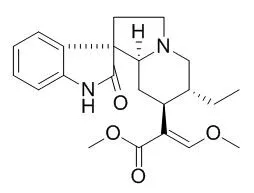| Kinase Assay: |
| Chinese Journal of Pharmacology & Toxicology, 2011, 25(1):68-71. | | Effect of rhynchophylline on platelet aggregation and cytoplasmic free calcium level in rabbits.[Reference: WebLink] |
METHODS AND RESULTS:
After Rhynchophylline (Rhy) 0.65 and 1.30 mmol·L-1 were administered, the cytoplasmic free calcium level induced by ADP decreased to 620 ± 37 and (528 ± 17) nmol·L-1, respectively (P < 0.05), the cytoplasmic free calcium level induced by thrombin decreased to 777 ±29 and (658 ±23) nmol·L-1, respectively (P < 0.05). In the absence of extracellular Ca+, Rhy had no significant influence on cytoplasmic free calcium level of rabbit platelet.
CONCLUSIONS:
Rhy markedly inhibits rabbit platelet aggregation induced by ADP or thrombin possibly by depressing the inflow of Ca+ and the rise of the cytoplasmic free calcium level in platelet. | | Eur J Pharmacol. 2002 Nov 22;455(1):27-34. | | Rhynchophylline and isorhynchophylline inhibit NMDA receptors expressed in Xenopus oocytes.[Pubmed: 12433591] | Rhynchophylline and isoRhynchophylline are major tetracyclic oxindole alkaloid components of Uncaira species, which have been long used as medicinal plants.
METHODS AND RESULTS:
In this study, the effects of Rhynchophylline and isoRhynchophylline on the ionotropic and metabotropic glutamate receptor-mediated current responses were examined using Xenopus oocytes injected with total RNA prepared from rat cortices or cerebelli. Rhynchophylline and isoRhynchophylline (1-100 microM) per se failed to induce membrane current, but these alkaloids reversibly reduced N-methyl-D-aspartate (NMDA)-induced current in a concentration-dependent but voltage-independent manner. The IC(50) values of Rhynchophylline and isoRhynchophylline were 43.2 and 48.3 microM, respectively. Substitution of Ba(2+) for Ca(2+) in the recording medium did not alter the extent of Rhynchophylline- and isoRhynchophylline-induced suppression of NMDA currents. In contrast, neither alkaloid had an effect on the currents mediated by ionotropic kainic acid-type and (+/-)-alpha-amino-3-hydroxy-5-methyl-4-isoxazolepropionic acid (AMPA)-type glutamate receptors or by the metabotropic glutamate receptor(1 and 5) (mGlu(1/5)). Rhynchophylline and isoRhynchophylline (30 microM) significantly reduced the maximal current responses evoked by NMDA and glycine (a co-agonist of NMDA receptor), but had no effect on the EC(50) values and Hill coefficients of NMDA and glycine for inducing currents. These alkaloids showed no interaction with the polyamine binding site, the Zn(2+) site, proton site or redox modulatory site on the NMDA receptor.
CONCLUSIONS:
These results suggest that Rhynchophylline and isoRhynchophylline act as noncompetitive antagonists of the NMDA receptor and that this property may contribute to the neuroprotective and anticonvulsant activity of the Uncaira species plant extracts. |
|
| Animal Research: |
| Int Immunopharmacol. 2012 Nov;14(3):243-51. | | Rhynchophylline prevents cardiac dysfunction and improves survival in lipopolysaccharide-challenged mice via suppressing macrophage I-κBα phosphorylation.[Pubmed: 22841535 ] | The purpose of the present study is to investigate the effect of Rhynchophylline (Rhy) on LPS-induced myocardial dysfunction in mice.
METHODS AND RESULTS:
We found that pretreatment with Rhy significantly improved cardiac systolic dysfunction, increased stroke volume and cardiac output in mice challenged with LPS. LPS induced cardiac inhibitor-κBα (I-κBα) phosphorylation, tumor necrosis factor-α (TNF-α) and interleukin-1β (IL-1β) mRNA expression, and in turn increased cardiac TNF-α and IL-1β protein production, all of which were attenuated by pretreatment with Rhy. Immunohistochemistry revealed that TNF-α was found in infiltrated macrophages (F4/80(+)) and myocardium, and Rhy reduced TNF-α immunostaining in cardiac infiltrated macrophages in LPS-challenged mice. Furthermore, Rhy inhibited LPS-induced I-κBα phosphorylation and TNF-α production in cultured mouse peritoneal macrophages, but not in neonatal mouse cardiomyocytes. Pretreatment with Rhy significantly decreased the mortality of LPS-challenged mice.
CONCLUSIONS:
These results indicate that Rhy reduces cardiac dysfunction and improves survival via suppression of macrophage I-κBα phosphorylation in LPS-challenged mice, and suggest that Rhy may be a potential agent for the treatment of septic cardiac dysfunction. | | Chinese Traditional & Herbal Drugs, 2014, 45(15): 2210-3. | | Antihypertensive effect and vascular regulation mechanism of rhynchophylline on spontaneously hypertensive rats[Reference: WebLink] |
METHODS AND RESULTS:
SHR were randomly divided into model, positive control(Captopril 6.25 mg/kg), low-, mid-, and high-dose(1.25, 2.50, 5.00 mg/kg) Rhy groups. Other SD rats were included as the control group. Rats in the model and control groups were given the same volume of distilled water once daily for 21 d. Rat tail artery SBP was measured before administration and day 7, 14, and 21 during the administration. The levels of plasma Ang II, ADMA, AT1 R, and serum NO, NOS were detected after the last administration underwent blood sampling. Compared with the model group, Rhynchophylline(Rhy) reduced SBP significantly. Moreover, the plasma Ang II, ADMA, and AT1 R levels were up-regulated, and the serum NO and NOS levels were decreased in the model group, which could be reversed by the treatment of Rhy(P 0.05, 0.01).
CONCLUSIONS:
Rhy could reduce the SBP of SHR significantly, decrease plasma Ang II, ADMA, and AT1 R levels, and promote serum NO and NOS levels, which has the protection of vascular endothelial function. |
|






 Cell. 2018 Jan 11;172(1-2):249-261.e12. doi: 10.1016/j.cell.2017.12.019.IF=36.216(2019)
Cell. 2018 Jan 11;172(1-2):249-261.e12. doi: 10.1016/j.cell.2017.12.019.IF=36.216(2019) Cell Metab. 2020 Mar 3;31(3):534-548.e5. doi: 10.1016/j.cmet.2020.01.002.IF=22.415(2019)
Cell Metab. 2020 Mar 3;31(3):534-548.e5. doi: 10.1016/j.cmet.2020.01.002.IF=22.415(2019) Mol Cell. 2017 Nov 16;68(4):673-685.e6. doi: 10.1016/j.molcel.2017.10.022.IF=14.548(2019)
Mol Cell. 2017 Nov 16;68(4):673-685.e6. doi: 10.1016/j.molcel.2017.10.022.IF=14.548(2019)